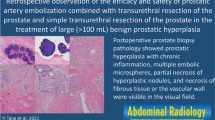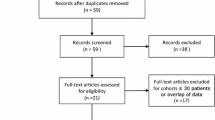Abstract
Background
There are growing interests for minimally invasive surgical techniques (MISTs) for the treatment of benign prostatic hyperplasia (BPH)-associated lower urinary tract symptoms (LUTS). Prostatic artery embolization (PAE) uses selective angioembolization of prostatic arteries, thereby reducing size to improve LUTS/BPH. However, real-world data comparing surgical outcomes between MISTs and tissue resective techniques are lacking. We assessed the differences in surgical outcomes between PAE, transurethral resection of the prostate (TURP), and prostatic urethral lift (PUL) in a real-world population for LUTS/BPH.
Methods
We present an observational population-based study of 12,902 men with BPH in New York State who received PAE, TURP, and PUL in outpatient and ambulatory surgery settings from 2014 to 2018. For short-term outcomes, we report 30-day and 90-day risks of readmission to inpatient and emergency room (ER) with/without complications and compared them across groups using χ2 tests and mixed-effect logistic regressions. For long-term outcomes, we report surgical retreatment and stricture rates using Kaplan–Meier failure curves and compared them using Log rank tests and Cox regression models.
Results
Of 12 902 men, 335 had PAE, 11,205 had TURP, and 1362 had PUL. PAE patients had the highest 30-day (19.9%) and 90-day (35.6%) risks of readmission to inpatient or ER (p < 0.01). Non-specific abdominal pain was the main diagnosis associated with 30-day and 90-day readmissions to inpatient or ER after PAE (14.3% and 26.8%, respectively). After 2 years of follow-up, PAE patients had the highest retreatment rate of 28.5% (95%CI 23.7–34.2%) compared to TURP (3.4% (95%CI 3.1–3.8%)) and PUL (8.5% (95%CI 5.6–12.9%)) (p < 0.001).
Conclusion
In a real-world population, PAE was associated with the most frequent 30-day and 90-day readmission to inpatient or ER and the highest retreatment rate among all surgical techniques even when controlled for individual patient comorbidities and surgical volume.


Similar content being viewed by others
References
Foo KT (2019) What is a disease? What is the disease clinical benign prostatic hyperplasia (BPH)? World J Urol 37(7):1293–1296. https://doi.org/10.1007/s00345-019-02691-0
Mayer EK, Kroeze SG, Chopra S, Bottle A, Patel A (2012) Examining the “gold standard”: a comparative critical analysis of three consecutive decades of monopolar transurethral resection of the prostate (TURP) outcomes. BJU Int 110(11):1595–1601. https://doi.org/10.1111/j.1464-410X.2012.11119.x
Roehrborn CG, Gange SN, Shore ND et al (2013) The prostatic urethral lift for the treatment of lower urinary tract symptoms associated with prostate enlargement due to benign prostatic hyperplasia: the L.I.F.T. Study. J Urol 190(6):2161–2167. https://doi.org/10.1016/j.juro.2013.05.116
Xiang P, Guan D, Du Z et al (2021) Efficacy and safety of prostatic artery embolization for benign prostatic hyperplasia: a systematic review and meta-analysis of randomized controlled trials. Eur Radiol 31(7):4929–4946. https://doi.org/10.1007/s00330-020-07663-2
Schreuder SM, Scholtens AE, Reekers JA, Bipat S (2014) The role of prostatic arterial embolization in patients with benign prostatic hyperplasia: a systematic review. Cardiovasc Intervent Radiol 37(5):1198–1219. https://doi.org/10.1007/s00270-014-0948-4
McVary KT, Roehrborn CG, Avins AL et al (2011) Update on AUA guideline on the management of benign prostatic hyperplasia. J Urol 185(5):1793–1803. https://doi.org/10.1016/j.juro.2011.01.074
Elixhauser A, Steiner C, Harris DR, Coffey RM (1998) Comorbidity measures for use with administrative data. Med Care 36(1):8–27. https://doi.org/10.1097/00005650-199801000-00004
World Health Organization (1977) Manual of the International Classification of Diseases, Injuries, and Causes of Death, Ninth Revision. World Health Organization, Geneva. Accessed 17 Apr 2022
World Health Organization (1992) International Statistical Classification of Disease and Related Health Problems, Tenth Revision (ICD-10). World Health Organization, Geneva. Accessed 17 Apr 2022
McWilliams JP, Bilhim TA, Carnevale FC et al (2019) Society of Interventional Radiology Multisociety Consensus Position Statement on Prostatic Artery Embolization for Treatment of Lower Urinary Tract Symptoms Attributed to Benign Prostatic Hyperplasia: From the Society of Interventional Radiology, the Cardiovascular and Interventional Radiological Society of Europe, Société Française de Radiologie, and the British Society of Interventional Radiology: Endorsed by the Asia Pacific Society of Cardiovascular and Interventional Radiology, Canadian Association for Interventional Radiology, Chinese College of Interventionalists, Interventional Radiology Society of Australasia, Japanese Society of Interventional Radiology, and Korean Society of Interventional Radiology. J Vasc Interv Radiol 30(5):627-637.e1. https://doi.org/10.1016/j.jvir.2019.02.013
Garden EB, Shukla D, Ravivarapu KT et al (2021) Rezum therapy for patients with large prostates (≥ 80 g): initial clinical experience and postoperative outcomes. World J Urol. https://doi.org/10.1007/s00345-020-03548-7
Abt D, Müllhaupt G, Hechelhammer L et al (2021) Prostatic artery embolisation versus transurethral resection of the prostate for benign prostatic hyperplasia: 2-yr outcomes of a randomised, open-label, single-centre trial. Eur Urol 80(1):34–42. https://doi.org/10.1016/j.eururo.2021.02.008
Uflacker A, Haskal ZJ, Bilhim T, Patrie J, Huber T, Pisco JM (2016) Meta-analysis of prostatic artery embolization for benign prostatic hyperplasia. J Vasc Interv Radiol 27(11):1686-1697.e8. https://doi.org/10.1016/j.jvir.2016.08.004
Shim SR, Kanhai KJ, Ko YM, Kim JH (2017) Efficacy and safety of prostatic arterial embolization: systematic review with meta-analysis and meta-regression. J Urol 197(2):465–479. https://doi.org/10.1016/j.juro.2016.08.100
Kim HS, Lee S, Kim JH (2018) Real-world evidence versus randomized controlled trial: clinical research based on electronic medical records. J Korean Med Sci 33(34):e213
Chen ML, Correa AF, Santucci RA (2016) Urethral strictures and stenoses caused by prostate therapy. Rev Urol 18(2):90–102. https://doi.org/10.3909/riu0685
Gao YA, Huang Y, Zhang R et al (2014) Benign prostatic hyperplasia: prostatic arterial embolization versus transurethral resection of the prostate–a prospective, randomized, and controlled clinical trial. Radiology 270(3):920–928. https://doi.org/10.1148/radiol.13122803
Acknowledgements
The data used to produce this publication were provided by the New York State Department of Health (NYSDOH). However, the conclusions derived, and views expressed therein are those of the author(s) and do not reflect the conclusions or views of NYSDOH. NYSDOH, its employees, officers, and agents make no representation, warranty, or guarantee as to the accuracy, completeness, currency, or suitability of the information provided here.
Funding
None.
Author information
Authors and Affiliations
Contributions
BLR: project development, data collection, manuscript writing. XZ: data collection, data analysis, manuscript writing. KO: manuscript writing. JM: data collection, data analysis, manuscript editing. KCZ: manuscript editing. DE: manuscript editing. NB: manuscript editing. TM: manuscript editing. AT: manuscript editing. SK: manuscript editing. AS: project development. BC: project development, manuscript editing.
Corresponding author
Ethics declarations
Conflict of interest
NB is a consultant and investigator for Boston Scientific, Olympus, and PROCEPT BioRobotics. BC is a consultant and investigator for Boston Scientific and Olympus. KCZ is a consultant for Boston Scientific, and PROCEPT BioRobotics. DE is a consultant and investigator for PROCEPT BioRobotics. All other authors report no relevant conflicts of interest.
Ethics approval
Not applicable.
Informed consent
Not applicable.
Additional information
Publisher's Note
Springer Nature remains neutral with regard to jurisdictional claims in published maps and institutional affiliations.
Rights and permissions
Springer Nature or its licensor (e.g. a society or other partner) holds exclusive rights to this article under a publishing agreement with the author(s) or other rightsholder(s); author self-archiving of the accepted manuscript version of this article is solely governed by the terms of such publishing agreement and applicable law.
About this article
Cite this article
Raizenne, B.L., Zheng, X., Oumedjbeur, K. et al. Prostatic artery embolization compared to transurethral resection of the prostate and prostatic urethral lift: a real-world population-based study. World J Urol 41, 179–188 (2023). https://doi.org/10.1007/s00345-022-04218-6
Received:
Accepted:
Published:
Issue Date:
DOI: https://doi.org/10.1007/s00345-022-04218-6




